

...but fear not, for Disney did a pretty good job at giving the world a feel for the Chinese culture. Sure, there are some changes, but if I wanted complete accuracy I'd watch something like National Geographic. That said, I still went and looked up some stuff anyway, mostly to satisfy my own curiosity. This just scratches the surface--for more details go to the library or look at China-related webpages.
Comments, corrections, additions? E-mail me! More will come when I get the time.
Mulan's origins most likely arose as a merger between the Tuoba (Toba) clan of the Xianbei culture and the Han Chinese. The Tuoba, whom originated from the far northeast, managed to conquer and rule northern China during the Northern Wei Dynasty (AD 386-534) despite being vastly outnumbered. Although some of the military aspects of Xianbei culture remained, the new rulers began adopted Chinese customs to maintain control over their subjects. Just as society became a blend of two cultures, Mulan is both a dutiful Chinese daughter and an accomplished soldier.
Obviously, the exact time and place in China where Mulan is set in an imaginary dynasty in an imaginary part of China, based on real customs and lands. Artistically, the film is influenced by artwork from the Han and Tang Dynasties. Judging from the technology and costumes, Disney's Mulan would be set much later than the Northern Wei Dynasty.
The Wall did have some real military value, however. Horses couldn't easily get over the 20-foot-high wall, and passes through the Wall were heavily guarded. When watchmen on patrol spotted trouble, they could signal from the towers.
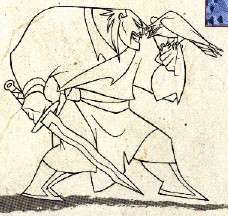 Around Mulan's time, the Huns were an Asiatic group which were invading Europe. (At least that's what one dictionary says.) But let me back up for a moment. The Huns, as they are called in the movie (and correctly), are actually what the western world calls the Mongols. Originally established in the Lake Baikal area of what was the USSR, they started trouncing their neighbors a few centuries before Christ. In doing so, they drove a lot of tribes
westward toward Europe, one of which came to be called the Huns (the confusion begins) by European historians. This tribe reached Europe a few centuries after Christ and, under Attila, more or less made things unpleasant for the Roman Empire. Meanwhile, the real Huns (Mongols) expanded slowly, building up giant nomadic tribes that eventually swept southward through China. (Contributed by Joey Kusnick.)
Around Mulan's time, the Huns were an Asiatic group which were invading Europe. (At least that's what one dictionary says.) But let me back up for a moment. The Huns, as they are called in the movie (and correctly), are actually what the western world calls the Mongols. Originally established in the Lake Baikal area of what was the USSR, they started trouncing their neighbors a few centuries before Christ. In doing so, they drove a lot of tribes
westward toward Europe, one of which came to be called the Huns (the confusion begins) by European historians. This tribe reached Europe a few centuries after Christ and, under Attila, more or less made things unpleasant for the Roman Empire. Meanwhile, the real Huns (Mongols) expanded slowly, building up giant nomadic tribes that eventually swept southward through China. (Contributed by Joey Kusnick.)
This dictionary also says that the word Hun (hun) is used to mean an outside invader. (In the Chinese opera film The Lady General Hua Mu-Lan, the Chinese army battles a group simply known as "the barbarians.") I think the second definition is a safer choice in this case.
Thanks to Kristen Fowler for all this!
The amount of freedom and education women received also depended on the philosophies and laws present in the dynasty she lived. Before the Song Dynasty, for instance, women from some wealthy families were well educated and enjoyed outdoor sports such as polo.
 ), including the watery porridge we see Mushu serving in the film (though the bacon and eggs seemed pretty American to me). Two interesting e-mails I received on this topic:
), including the watery porridge we see Mushu serving in the film (though the bacon and eggs seemed pretty American to me). Two interesting e-mails I received on this topic:"Notice the grain of rice Mulan makes stand up with her chopsticks at the beginning of the film? And how it falls down? It shouldn't do that. The way Chinese cook rice, a lot of water is used and the rice is all puffed up and sticky. For one, it would end up stuck on the chopsticks and even if she managed to avoid that, the grain of rice would stay standing or fall down very slowly." (Contributed by Suz.)
"I can never remember who eats the short grain and who eats the long grain rice, but the Japanese rice (as cooked) is usually the stickier, as you describe, but Cantonese usually cook the rice so that the grains often do not stick together. That's why the Japanese can pick up a 'bite' of rice from the rice bowl, while Cantonese often bring the bowl up to their mouth and push the rice into their mouth. I am Cantonese, so that was the kind of rice we ate growing up, but later, I switched to 'Japanese' rice (probably when we started using a rice cooker) which comes out stickier. I don't know about other areas of China." (Contributed by Jeffrey Y. Sue.)
"When Mulan is writing her notes for the Matchmaker's, her rice bowl had her chopsticks standing straight up, which indicates that it is an offering to the ancestors and would not be eaten. If she was going to eat it, she should have put the chopsticks across the rim of the bowl. If I was her, I would use that rice for good luck instead of eating. She needs it!:) (Contributed by ajohn!)
The Fa temple has a number of stone tablets, but stone tablets are reserved for grave sites. Tablets used for worshipping ancestors at home are made of wood. (Contributed by Y.T. Tsai.)
"These days it's quite true that most Chinese people have three-character names. However, I don't think this was necessarily so in the earlier dynasties. For instance, in Three Kingdoms, which takes place right after the Han Dynasty, every character (who didn't have a two-character surname) had a two-character name: surname + identifying name (e.g., Liu Bei). Also, the naming system seemed to be applied most strictly to males, so it didn't seem too unusual to me that the soldiers in Mulan had two-character names. Females had it weirder, it seems. Commoners often got descriptive names (not even really formal identifying names, but more like a descriptive nickname), and often times their surnames would be disregarded along the way; they would say 'so-and-so from the fill-in-the-blank family.' Women of class were often just referred to as 'Lady surname,' with no reference to an identifying name." (Contributed by Jeffrey Chen.)
Mulan's mother is called Fa Li in the movie. In China after a girl marries she is still called by her maiden name by her friends and family, though legally she is known as Mrs. (husband's surname). If I remember correctly only one of the matchmaker's helpers addresses Fa Li by name--so it might depend on how well she knows Mulan's mom.
Many Chinese names have meanings, with blessings and positive adjectives being common. Examples would be "prosperous," "lucky," "ambitious," "high achievement," "youthfulness," "strength," and so on. Some names are based on objects, such as jade or various flowers. The translations for some of the characters' names in Mulan are here. (Contributions by Herman Chang and Suz.)
 I haven't found anything on this. :( I do know that crickets have been depicted in Chinese artwork, but I have no idea why they are considered lucky. (Is this a regional thing? Several Chinese people I know hadn't heard of this superstition.) I have heard of crickets being kept in cages. Also, two crickets put together will fight, which was a form of entertainment. (Contribution by Yee Cai Goh.)
I haven't found anything on this. :( I do know that crickets have been depicted in Chinese artwork, but I have no idea why they are considered lucky. (Is this a regional thing? Several Chinese people I know hadn't heard of this superstition.) I have heard of crickets being kept in cages. Also, two crickets put together will fight, which was a form of entertainment. (Contribution by Yee Cai Goh.)"If I remember correctly, crickets were kept in wicker cages by students and such who like to sing to them while they worked. Although I cannot remember either how they are lucky, they are at least special in this way. :) I've seen some of the crickets they sell on the streets in China, and let me say, they are HUGE!!!! :)" (Contributed by "R")
It is a pity there is so sparse use of Chinese musical instruments, because if properly used it can create very special effects and atmospheres. Only the di, a Chinese bamboo flute was used more prominently. It is that reedy, trembling sound that you hear quite often in the score by Goldsmith. The gu-zheng, a kind of horizontal Chinese harp, can also be heard very sparingly. Here are some of the places I've heard them more prominently:
Track 7: [04:30] - there is a short, comical little phrase here with the di which sounds like birds chirping. I think it's a sort of Cri-Kee theme.
Track 9: [04:05] - another short di phrase.
Track 10: [00:33][00:48][00:54][01:21] - there are glissando effects with the gu-zheng at all these parts, but very little only.
Track 2: you can also hear a very short part with the gu-zheng after Lea sings the last word, "inside..." and the gu-zheng
comes on very softly, very short.
The di is also extensively featured in "Honor To Us All," "A Girl Worth Fighting For," and a bit of "Reflection."
Thanks to Dennis Lee for all this!
 One thing that distinguished the Chinese from the "barbarians" was that the Chinese kept their hair tied neatly in a bun while outsiders let their hair fly freely, like ghosts. Both Chinese men and women tied back their hair, pulling it back from their faces. Notice in the film that this rule holds true for all the characters except Mulan, who can be seen with her hair down in several scenes. Fa Li's hairstyle is a Tang or Song Dynasty style, but many of the women have Japanese-style hairdos. (From what I understand Chinese women didn't have hair flairing out at the sides.) (Contributions by Dennis Lee & Yee Cai Goh.)
One thing that distinguished the Chinese from the "barbarians" was that the Chinese kept their hair tied neatly in a bun while outsiders let their hair fly freely, like ghosts. Both Chinese men and women tied back their hair, pulling it back from their faces. Notice in the film that this rule holds true for all the characters except Mulan, who can be seen with her hair down in several scenes. Fa Li's hairstyle is a Tang or Song Dynasty style, but many of the women have Japanese-style hairdos. (From what I understand Chinese women didn't have hair flairing out at the sides.) (Contributions by Dennis Lee & Yee Cai Goh.)
"Weiqi ('Go') would have required her to pick up a pip from a bin and place it somewhere on the board, a la Othello. However, she clearly moved a piece from one position to another. Besides, the grid on the board was definitely a Chinese Chess board :-)"
Now whether the move was legal is another question...
Contributed by Paul English and Jeffrey Chen.
The Chinese collar (shirtfront) is folded left over right (LoR) for both men and women. (For Western clothes, males wear LoR and females wear right over left (RoL).) In Mulan, this is correct for every costume for every character *except* Mulan's last costume, the one used to disguise as a concubine, is worn RoL! Strictly speaking, this is wrong. Some tribes in China, and during some Dynasties, certain positions in court and certain personalities, wear it RoL. In Japan (which is not China but this is interesting anyway), they only dress people RoL when they are dead." (Contributed by Dennis Lee.)
The Emperor's clothes. Just as purple is the color for European royalty, yellow was worn by the Chinese royalty.
Earrings. "The earrings Mulan wore to the matchmaker are way too modern. Notice how she pulled them right off after getting home? Does that mean those are clip earrings? I don't believe that clip earrings were invented until this century. In ancient China, all earrings were pierce earrings. In one version of the story, Mulan had to lie to cover up why she had pierced earlobes. I guess the writers just decided to omit the pierced earlobes altogether by having her wear clip earrings." (Posted to rec.arts.disney.animation by Jas.)
Armor. The soldiers' armor is based on a style from the Tang Dynasty (AD 618-907) known as lamellar armor. The leather shoes are based on footwear from the Qin Dynasty (second century BC). Chinese soldiers really wore boots, but shoes were used in the film to provide contrast with the boot-wearing Huns.
Makeup. According to character designer Chen-Yi Chang, women made up their faces by applying white powder and rouge from the Sui and Tang Dynasties and the Five Dynasties era. This form of appearance was common through the Qing Dynasty. Today it is mostly seen in Chinese opera and also often worn by Japanese geishas. (Information from Sinorama, August 1999 issue.)
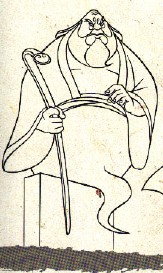 The staff the First Ancestor wields is shaped somewhat like a Chinese scepter with the curved end. The First Ancestor was designed to be very grand and regal, so this seems appropriate. Scepters originated as backscratchers (so I've been told), but later were decorated and personalized for the owner and eventually lost their purpose to help get rid of that irritating itch.
The staff the First Ancestor wields is shaped somewhat like a Chinese scepter with the curved end. The First Ancestor was designed to be very grand and regal, so this seems appropriate. Scepters originated as backscratchers (so I've been told), but later were decorated and personalized for the owner and eventually lost their purpose to help get rid of that irritating itch.
In Chinese painting and porcelin, a dragon's rank is determined by the number of toes on its feet. A dragon with five toes per foot is the Emperor's emblem. Dragons used by ministers or temples have four toes per foot, and the common person's dragons have three toes on each foot. (Since Mushu has four fingers on his front paws and two on his back, I guess that averages out to three per foot.) Another thing to look for is whether the dragon is looking at you. Non-royal dragons will have a right or left profile, but the emperor's dragon will have two eyes. (With contributions by Dale Hwang and Y.T. Tsai.)
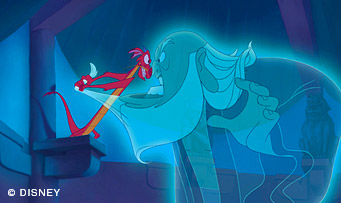
Mushu's demotion reminds me of another famous Chinese tale, Journey to the West, also known as the Monkey King stories. While Monkey, Pigsy, and Sandy are the three famous disciples of the priest, there is also a fourth disciple. This fourth disciple was a Dragon Prince who was disrespectful to his father. He becomes the horse for the priest. (Maybe this explains the animosity between Mushu and Khan?)
"Chien-Po says, 'Ah mo ah mi toh fu...' It's actually, 'Ah mi twoh foh.' (This is just my phonetic spelling, I'm not using pinyin or anything like that) It means something to the effect of 'God help me.'" (Contributed by Suz.)
"While 'ami to fu' is the more common saying, Buddhist priests, when chanting in front of the Buddha, would say 'namor ami tofu.'" (Contributed by Susan Cheng.)
"When I was growing up, I spent a lot of time with Japanese friends who were Buddhists. Chien-Po seems to be saying, 'Amida Butsu'. I remember the Buddhist chant as 'Namu Amida Butsu'. I think this is from the original language spoken by Buddha and the early Buddhists (in India) and not Japanese. In Hawaii, there are a lot of Buddhists, and there is often a chuckle in the theater when Chien-Po is chanting because I think they recognize it also." (Contributed by Jeffrey Y. Sue.)
"'Namu Amida Butsu' is the chant used by Shin Buddhism in Japan. It's called the 'nembutsu.' It means (loosely) 'I pray to you Infinite Light (or Eternal Light).' Shin Buddhism became popular (though it existed earlier, I think) in Japan in the late 12th through mid-13th century. It is often referred to as the 'Pure Land' School. Its popularity was influenced to some degree by Christianity and, of course, a particular form of Buddhism that came to Japan via China via India. The Indian term would have been 'Amithaba Buddha' not 'Amida Buddha' (this is Japanese). Shin Buddhism is the most popular Japanese form of Buddhism." (Contributed by C.S. BigTrees.)
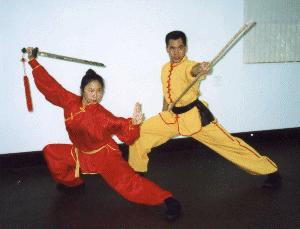
It's been pointed out that the poem came at least 200 years before the gunpowder came along, so the soldiers shouldn't be using cannons and stuff...but hey, it's a movie.
Contributed by "ShdwRlm"
Sexist, huh?  (Contributed by August Paul Yang.)
(Contributed by August Paul Yang.)
Slightly above "wei xian" are some more Chinese characters which translate to "The Big Bamboo." This is the name of a bar in Kissimmee, Florida where some of the Mulan crew hung out. (Contributed by Tangming Fong and John Sun.)
Shang more than likely would have no experience in talking to an unmarried young woman like Mulan. He knew how to talk to her when she's Ping, but not when she's Mulan. (Posted to rec.arts.disney.animation by Jas.)
In real life, the answer would have been no. The common people kept a respectful distance between themselves and the Emperor (who usually was surrounded by bodyguards and other officials). I think at one point Disney did not have Mulan hugging the Emperor, but this was changed to reflect Mulan's impulsive, warm personality.
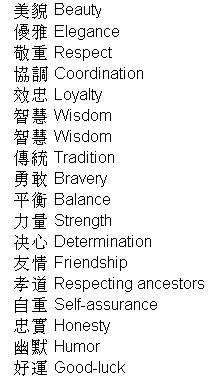
Thanks to Tangming Fong for this list!
This page hosted by Geocities. Created July 26, 1998. Updated July 20, 2004.
Information also provided from the books The Horizon History of China by C. Fitzgerald and The Land and People of China by J. Major.
Back to the Mulan FAQ.